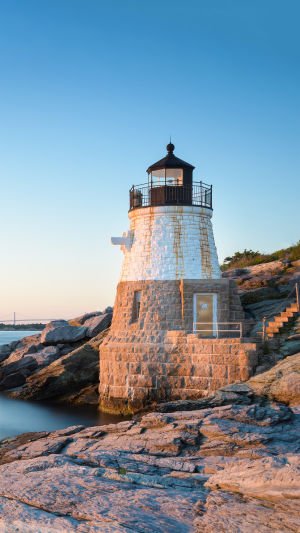A lighthouse is a tall, tower-shaped structure that is installed with lighting equipment on top of it. Its position is intended to be conspicuous to help guide ships safely through dangerous waters. The lighthouse should have a specific architectural shape so that it is easy for ships to distinguish it from other structures.
Because the Earth's surface is curved, the tower body must have a sufficient height to ensure that the lights can be seen by long-distance ships. The general line-of-sight distance is 15-25 nautical miles. However, the light should not be too high, so as not to be obscured by high clouds.
Depending on the size of the lighthouse and the characteristics of the location, the lighthouse can be guarded or unguarded. Important lighthouses should always have a guard stationed to maintain the equipment and ensure its proper functioning.
Although humans have been building lighthouses as early as BC, the technology used in lighthouses at that time was still very primitive. Due to the limitations of the construction methods available, people could not build lighthouses in offshore waters at that time.
The lighthouses built during this time were generally constructed on the coast or islands not far from the shore.
The lighthouse is composed of lamps and the tower body. The tower body can be constructed of various building materials, mainly to adapt to and resist harsh natural conditions such as wind and waves, to maintain its own stability and durability. The height of the tower body should meet the requirements of the light range.
Compared to the tower, the light used in the lighthouse is the core part. The light source used in traditional lighthouses is animal and vegetable fats, and the brazier is placed on the surface of mercury to keep it stable. Workers stationed in the lighthouse use clockwork to drive the mirror behind the fire source to rotate at a constant speed so that the fire light is projected in all directions.
There are many beautiful lighthouses around the world, such as the Formento Lighthouse, located on the northernmost tip of the Balearic Islands in Mallorca.
Sitting atop a high cliff with a steep waterfall below, this lighthouse has been alerting sailors to the dangers of Mallorca's coastline since 1863. It is unmissable due to the outstanding natural beauty of its surroundings and wonderful views of the Mediterranean Sea.
The Biarritz Lighthouse in France is another notable lighthouse located next to the Biarritz beach. Built in 1834, it stands 73 meters tall and is one of the tallest lighthouses in Europe. This cylindrical, white lighthouse is a famous landmark on the west coast of France.
Ireland's Kilmark Duy Lighthouse is located in Whitford, southern Ireland, and was built in 1837. Standing 36 meters high, it is a conical lighthouse with pale gray stone and white walls. The scenery around the lighthouse is beautiful, and it is a popular spot for photographers and tourists.
The Portland Lighthouse in Maine, USA, was built in 1791 and is famous all over the world for its beautiful appearance and stunning beach views. Located on Cape Elizabeth, Maine, there is a trail around the lighthouse that offers beautiful views of the ocean and rocky landscape.
Australia's Byron Bay Lighthouse, built in 1901, is located in Byron Bay, New South Wales, Australia. Standing at 22 meters high, it is one of Australia's oldest and most popular lighthouses, and the surrounding scenery is spectacular. From the top of the lighthouse, visitors can overlook the ocean and surrounding mountains.
Lighthouses have played a crucial role in maritime navigation throughout history, but with advancements in technology, they are no longer the sole means of guiding ships through treacherous waters. However, they remain important symbols of maritime history and heritage.
In addition to their functional purposes, lighthouses have become popular tourist attractions around the world, drawing visitors to their stunning views and rich history. From the rugged cliffs of Ireland to the sandy beaches of Australia, lighthouses continue to captivate the imagination of people of all ages.
Lighthouses are essential navigational aids that have helped sailors safely navigate the seas for centuries. They come in various shapes and sizes and are located in some of the most beautiful and challenging environments in the world.
While modern technology has made them less essential for navigation, they remain important symbols of maritime heritage and are popular tourist destinations that continue to captivate visitors with their stunning views and rich history.





